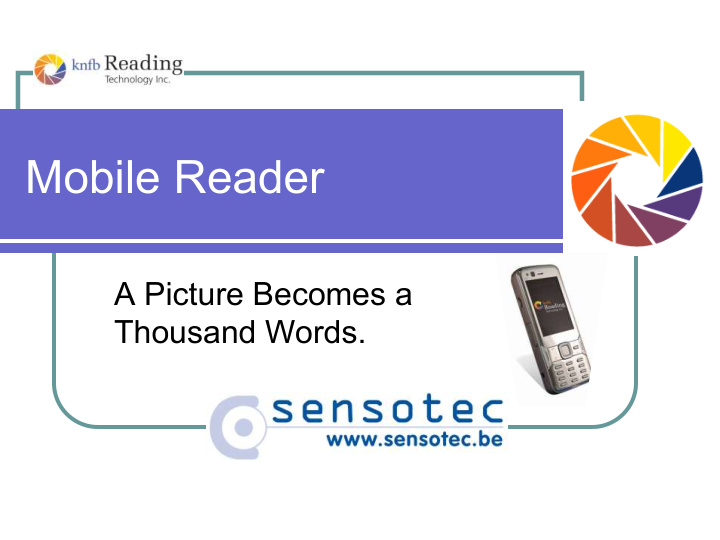



Mobile Reader A Picture Becomes a Thousand Words.
Mobile Reader • Introduction • Mobile Reader History • Mobile Reader Demonstration • Questions
Introduction
Introduction: Sensotec Founded in 1986 as innovative company Roots in the Royal Institute Spermalie Development of technological aids for reading impaired persons First product: Braildec From 2003: broader product range with technical aids for people with dyslexia
Introduction: Sensotec 2009: Core business: own development and production, localisation of third-party products, national and international distribution Projects: EU-projects, Audiokrant, Woody Growing export; growing number of distributors Relentless grow: now 33 employees
Introduction: Our products Braildec
Introduction: Our products EuroScope
Introduction: Our products Reporter
Introduction: Our Localized Products Kurzweil 1000 & Kurzweil 3000
Introduction: Our Localized Products Mobile Reader Sensotec has the exclusive rights for the localization and distribution of the Mobile Reader product line in Europe The Mobile Reader is currently available in following languages: Dutch, English, French, German, Italian, Spanish, Danish, Norwegian, Polish, Portuguese and Swedish
Mobile Reader: History Ray Kurzweil The man behind the Mobile Reader products
Mobile Reader: History Famous inventor, futurist and writer 1974: Foundation of Kurzweil Computer Products and developed first omni-font OCR system, applied in the first “reading machine” – in cooperation with National Federation of the Blind
Mobile Reader History
Mobile Reader: History 1996: Foundation of Kurzweil Educational Systems. Result: K1000 and K3000. Afterwards taken over by Lernout & Hauspie, now in hands of Cambium Learning technologies 2005: introduction of K-NFB Reader
Mobile Reader: History October 2007: KnfbReading Technology Inc and Sensotec sign localisation and distribution agreement. Commercial field Sensotec: European Union, except of UK and Ireland Turkey, Mongolia, Azerbaijan, Uzbekistan, Tajikistan, Turkmenistan Brazil, Angola, Cape Verde, Guinea-Bissau, Mozambique, Timor- Leste January 2008: introduction mobile reader product range in US
Mobile Reader: History
Mobile Reader: History and Future May 2008: Introduction of the first localized language versions on Sight City (Frankfurt): Dutch, French, German, Italian, Spanish December 2008: Introduction of multilingual device and new languages: Danish, Swedish, Norwegian and Portuguese Februari 2009: Introduction of Polish language; Reader now also compatible with Nokia 6220 Classic June 2009: European release of Version 6.0 with new Translation and Search functionality and new languages: Brazilian Portuguese, Turkish, Finnish, ...
Demonstration
Mobile Reader: Demonstration First pocket-size solution to reading on the go: Mobile Reader software on smartphone (only Nokia N82 and Nokia 6220 Classic) 114g instead of 8kg Take a picture of printed text and it will be read to you Pocket-size, so usable wherever the user happens to be Mobile Reader: knfbReader and kReader knfbReader: blind or low-vision users kReader: users who have difficulty reading due to learning or language problems (dyslectici, …)
Mobile Reader: Demonstration Place phone in center of page Lift 30 cm and obtain position Using sight: viewfinder Using voice commands: Field of view report Useful tip: distance elbows - hand Taking picture Reading start automatically, almost instantly Cancel (*) Pause reading: enter Reading: spoken text and text display on phone screen (3 enlargment levels)
Mobile Reader: Demonstration Navigation through text Save text and/or image file (automatically or manually) Wireless (bluetooth) or USB export / import to PC Filemanager Reprocess image: Keypad 4 No need to take a new picture of text Used when coloms need to be ignored or reading language needs to be changed
Mobile Reader: Demonstration Other Settings: Audio: voice (system and reading), language (system and reading), speed and volume Navigation Screen: text display and text orientation Reading format Camera flash Automatic saving Auto-exit Reading documents with multiple pages
Mobile Reader: Demonstration The Reader CAN read Every printed text of a general acceptable print quality The Reader CAN NOT Read Handwriting or printed text that resembles very much handwriting Screen Text (PC or LCD) External factors that influence Reading results Ambient lighting, glare and shadows Distance between Reader and target text Text size and layout, Structure, formate and color of text and background Obstructions (such as fingers, or neckties)
Mobile Reader: Demonstration Why only Nokia N82 and 6220 Classic? Operating System and memory Camera 5 megapixel, Autofocus, Xenon Flash Polarizers Absolutely necessary for suppressing the flash glare from shiny surfaces and shadows
Questions?
Recommend
More recommend